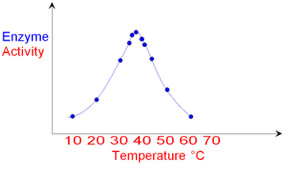The terms dependent and independent variable apply mostly to experimental research where some variables are manipulated, and in this sense they are "independent" from the initial reaction patterns, features, intentions, etc. of the subjects. Some other variables are expected to be "dependent" on the manipulation or experimental conditions. That is to say, they depend on "what the subject will do" in response. Somewhat contrary to the nature of this distinction, these terms are also used in studies where we do not literally manipulate independent variables, but only assign subjects to "experimental groups" based on some pre-existing properties of the subjects. For example, if in an experiment, males are compared to females regarding their white cell count, gender could be called the independent variable and white cell count the dependent variable.

The research is interested in measuring the activity of a particular enzyme at different temperatures.
In the experiment, the researcher would adjust the temperature and then measure the enzyme activity. The variable that is being controlled (adjusted) is temperature, so this is the independent variable and the variable that is being measured is enzyme activity, so this is the dependent variable.
This sounds counter-intuitive but it is the correct way round!